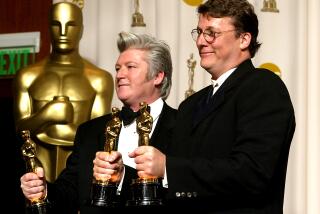Red Alert, Red Alert : From Auburn to Strawberry, New Colors Are Turning Heads
- Share via
THAT’S IT. I’m doing it,” a woman was overheard saying as she left a Marina del Rey theater showing “White Palace.”
“What? You’re trading me in for a younger man?” her companion asked.
“Not that,” the woman said dismissively. “I’m coloring my hair like Susan Sarandon’s.”
This season, Hollywood is turning redder with each new film release. And hair that’s been showing up on the screen is showing up on the street in living color.
“The ‘90s will be the decade of the redhead,” predicts Louis Licari of Louis Licari Color Group, a Manhattan salon that specializes in custom color. And he should know. Licari, a consultant to Clairol, helped clients Kim Basinger and Ellen Barkin realize their blond ambition, and it is he who was responsible for Sarandon’s sultry red mane.
Traditionally, blondes have always been lusted after and brunettes have always been considered classy, but redheads have always been, well, noticed. That might be because there are so few of them. “Only 6% of people are naturally red,” Licari says.
Of course, red locks aren’t new. A glance at a Who’s Who of red hair (natural and otherwise) proves that history has known some famous redheads: Alexander the Great (reddish-blonde); Mary, Queen of Scots, and Sarah Ferguson, the current Duchess of York (both carrot tops); Katharine Hepburn (auburn); Sarandon and her “White Palace” co-star, James Spader (chestnut and ginger, respectively); Brat Packer Molly Ringwald (strawberry red), “Nightline” anchor Ted Koppel (russet) and Raisa Gorbachev, whose bright copper-colored coif was dubbed “Raisa Red” during her first visit to the United States.
Hollywood aside, Steve Lococo, manager of the Borrelli Salon in West Hollywood, believes that the trend toward red has much to do with the popularity of the environmental movement and the natural colors it has inspired. “The ideal reds are ones that are drawn from the palette of a New England autumn,” he says. At Borrelli, “we like to start with a rich chestnut color, then give it decidedly gold or decidedly red highlights and cover the entire head with a glaze (a sheer, semi-permanent sheet of color) to tie it all together.”
Stylist-colorist Edward Salazar of Jadss on La Brea Avenue has another theory about the resurgence of red. He thinks it might have something to do with maturing baby boomers. “Face it,” Salazar says, “people in their 30s and 40s form the largest chunk of the U. S. population right now. Hair with red tones is flattering to a large number of people; it’s softer and a bit more youthful.” Salazar, whose cable TV show, “30 Minutes With Salazar,” regularly addresses the color issue, says the red tones his clients ask for vary by season: “During the winter, a lot of them want their color warmed. In the summer, they want it lightened a little.”
Ten years ago, if a client asked for red hair, the choices were fairly narrow. Thanks to technology, the spectrum of shades is much, much wider today. The expanded options, however, make it more difficult to decide which red is right for an individual’s skin tone.
“If you’re lucky enough to be milky-white, you can go as red as you want,” Licari says. People with olive complexions do better with subtle highlights, he says, “because too much red--or too light a shade--can easily make them look yellow.” Blacks, Asians and Latinas usually find dark red, rather than blond, highlights most attractive.
“Thanks to the fact that these new reds come in a wider range and are more believable,” Licari says, “we’re getting a different take on what red is--soft, beautiful and romantic.”
Romantic? Who knows? Maybe the market for red hair is heating up because the cold war between men and women is starting to thaw. “You always expect a redheaded woman to be a little saucy, to have a somewhat tangy personality,” Salazar says. “A certain shade of red gives one distinction. You’re going to be noticed when you enter a room.” Unless, of course, everyone else has gone red before you.
Photographed by Ann Elliot Cutting; hair and makeup: Alicia; model: Beth Kerin / Prima
More to Read
Only good movies
Get the Indie Focus newsletter, Mark Olsen's weekly guide to the world of cinema.
You may occasionally receive promotional content from the Los Angeles Times.










